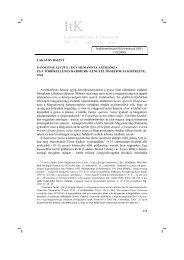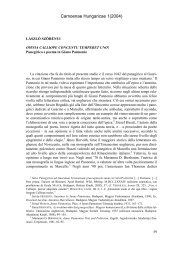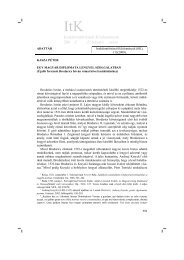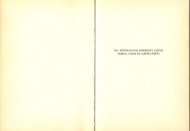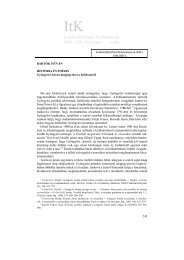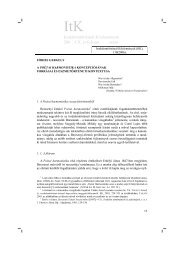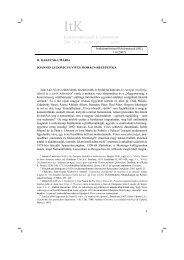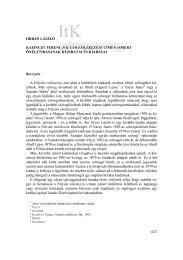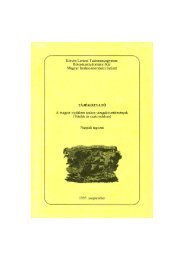Camoenae Hungaricae 3(2006) - Irodalomtörténeti Közlemények
Camoenae Hungaricae 3(2006) - Irodalomtörténeti Közlemények
Camoenae Hungaricae 3(2006) - Irodalomtörténeti Közlemények
You also want an ePaper? Increase the reach of your titles
YUMPU automatically turns print PDFs into web optimized ePapers that Google loves.
<strong>Camoenae</strong> <strong>Hungaricae</strong> 3(<strong>2006</strong>)<br />
the papers of the Bolognese soldier, scholar and diplomat resisted all systematic attempts<br />
at publication. The exception is a typical one: exactly two decades ago, Raffaella Gherardi<br />
published the political dispatches that Marsili sent to the Emperor in Vienna after the<br />
peace treaty of Karlowitz (1699) when he headed up an imperial delegation to determine<br />
the new boundaries between the Turks, the Habsburgs and the Venetians. 15 The publication<br />
was made under the aegis of a research project 16 focusing on the efforts at modernising<br />
the Habsburg state during the early 18 th century. Gherardi highlighted two aspects of<br />
Marsili’s intellectual habitus as relevant: his sympathy for the Merkantilpartei which was<br />
organised on the basis of the works of the Austrian cameralists, such as Becher, Schröder,<br />
Hörnigk and others, and the pivotal nature of the notion of notitia rerum publicarum<br />
(originating from Hermann Conring’s strictly scientific concept of politics) in his various<br />
political projects and memoranda. 17 Gherardi places Marsili’s intellectual development at<br />
a highly important junction in the European history of ideas. The pillars of his thought—<br />
the discarding of a theologically and ethically based idea of politics and the emergence of<br />
an approach focusing on administrative aspects and the encyclopaedic employment of<br />
statistics, demographics, geography and historical science in the organisation of a given<br />
state (in this case the Habsburg Empire)—provide a new, modernising context for the<br />
violent political phenomena of the day, some of which he instigated and the Habsburg<br />
government put into practice. The religious homogenization, the large-scale resettlements<br />
after the Turkish wars, the efforts to eliminate the autonomy of the Church and of the<br />
various social orders, etc., were viewed and understood for a long time by national historiographies<br />
(in Hungary and elsewhere in the Habsburg territories) only in terms of injuries<br />
and offences. Gherardi was right in pointing out that in Marsili’s thinking, politics<br />
and science formed a dynamic unity, more precisely, that the military and diplomatic<br />
moves of the Bolognese count were inspired by the new political science of his day.<br />
However, because Gherardi’s research project focused on a single period in Marsili’s<br />
career (the period of the peace negotiations and the border survey of 1699–1701) she<br />
paid less attention to the other side of the coin, namely to what extent political perspectives<br />
influenced Marsili’s scientific efforts or whether there was such influence at all in<br />
the last two decades of his life after he had been forced out of Viennese politics. The<br />
manuscript background material of the published reports and the organisation by Marsili<br />
DEÁK Antal András, A Duna fölfedezése (The discovery of the Danube), in: MARSIGLI 2004, ed. cit., 8–88.)<br />
The Hungarian translation and commentaries of Stato militare dell’Impero Ottomano, suoi progressi e sua<br />
decadenza (Amsterdam, 1732) is being prepared by Mónika F. Molnár, cf. F. MOLNÁR 2005, op. cit., 46.<br />
15 Luigi Ferdinando MARSILI, Relazioni dei confini della Croazia e della Transilvania (1699–1701), I–II, a<br />
cura di Raffaella GHERARDI, Modena, 1986 (hereafter: Relazioni).<br />
16 For monographic treatment see Raffaella GHERARDI, Potere e costituzione a Vienna fra Sei e Settecento:<br />
Il «buon ordine» di Luigi Ferdinando Marsili, Bologna, 1980.<br />
17 ID., Itinerario di un Staatswerdung: Il patrimonio austriaco di modernizzazione fra XVII e XVIII secolo,<br />
in: La dinamica statale austriaca nel XVIII e XIX secolo, strutture e tendenze di storia costituzionale prima e<br />
dopo Maria Teresa, a cura di Pierangelo SCHIERA, Bologna, 1981, 65–92; ID., Scienza e governo della frontiera:<br />
Il problema dei confini balcanici e danubiani nella pace di Carlowitz, Il pensiero politico (Bologna),<br />
32(1999), 323–351.<br />
115



